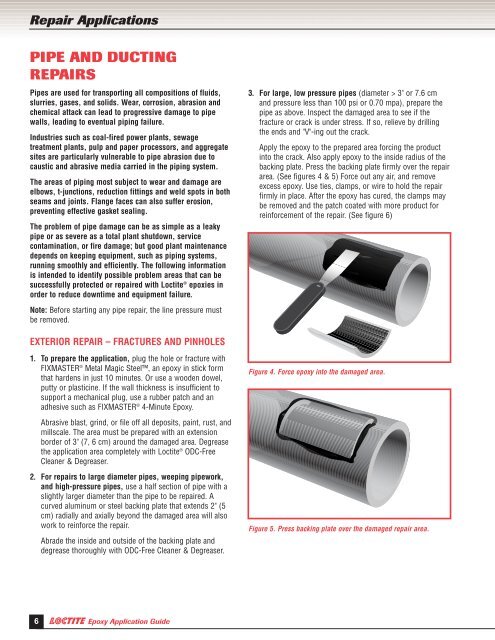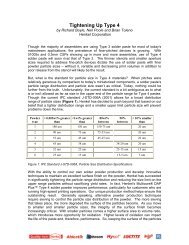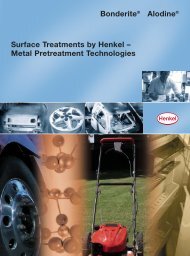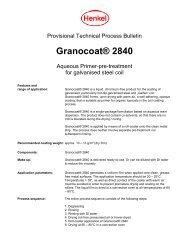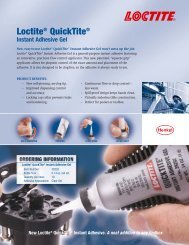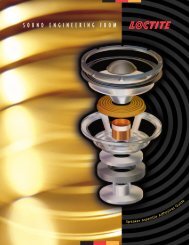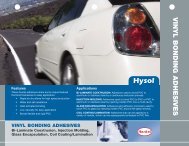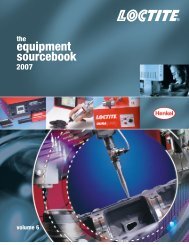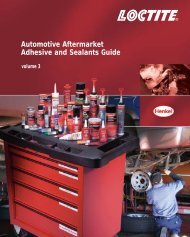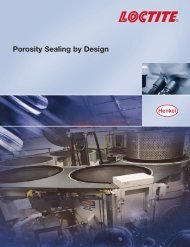Epoxy Application Guide - Loctite.ph
Epoxy Application Guide - Loctite.ph
Epoxy Application Guide - Loctite.ph
Create successful ePaper yourself
Turn your PDF publications into a flip-book with our unique Google optimized e-Paper software.
Repair <strong>Application</strong>sPIPE AND DUCTINGREPAIRSPipes are used for transporting all compositions of fluids,slurries, gases, and solids. Wear, corrosion, abrasion andchemical attack can lead to progressive damage to pipewalls, leading to eventual piping failure.Industries such as coal-fired power plants, sewagetreatment plants, pulp and paper processors, and aggregatesites are particularly vulnerable to pipe abrasion due tocaustic and abrasive media carried in the piping system.The areas of piping most subject to wear and damage areelbows, t-junctions, reduction fittings and weld spots in bothseams and joints. Flange faces can also suffer erosion,preventing effective gasket sealing.The problem of pipe damage can be as simple as a leakypipe or as severe as a total plant shutdown, servicecontamination, or fire damage; but good plant maintenancedepends on keeping equipment, such as piping systems,running smoothly and efficiently. The following informationis intended to identify possible problem areas that can besuccessfully protected or repaired with <strong>Loctite</strong> ® epoxies inorder to reduce downtime and equipment failure.Note: Before starting any pipe repair, the line pressure mustbe removed.3. For large, low pressure pipes (diameter > 3" or 7.6 cmand pressure less than 100 psi or 0.70 mpa), prepare thepipe as above. Inspect the damaged area to see if thefracture or crack is under stress. If so, relieve by drillingthe ends and "V"-ing out the crack.Apply the epoxy to the prepared area forcing the productinto the crack. Also apply epoxy to the inside radius of thebacking plate. Press the backing plate firmly over the repairarea. (See figures 4 & 5) Force out any air, and removeexcess epoxy. Use ties, clamps, or wire to hold the repairfirmly in place. After the epoxy has cured, the clamps maybe removed and the patch coated with more product forreinforcement of the repair. (See figure 6)EXTERIOR REPAIR – FRACTURES AND PINHOLES1. To prepare the application, plug the hole or fracture withFIXMASTER ® Metal Magic Steel, an epoxy in stick formthat hardens in just 10 minutes. Or use a wooden dowel,putty or plasticine. If the wall thickness is insufficient tosupport a mechanical plug, use a rubber patch and anadhesive such as FIXMASTER ® 4-Minute <strong>Epoxy</strong>.Figure 4. Force epoxy into the damaged area.Abrasive blast, grind, or file off all deposits, paint, rust, andmillscale. The area must be prepared with an extensionborder of 3" (7, 6 cm) around the damaged area. Degreasethe application area completely with <strong>Loctite</strong> ® ODC-FreeCleaner & Degreaser.2. For repairs to large diameter pipes, weeping pipework,and high-pressure pipes, use a half section of pipe with aslightly larger diameter than the pipe to be repaired. Acurved aluminum or steel backing plate that extends 2" (5cm) radially and axially beyond the damaged area will alsowork to reinforce the repair.Abrade the inside and outside of the backing plate anddegrease thoroughly with ODC-Free Cleaner & Degreaser.Figure 5. Press backing plate over the damaged repair area.6 <strong>Epoxy</strong> <strong>Application</strong> <strong>Guide</strong>


